Val Nicastro puts her best foot forward as she walks the Via Peuceta hiking route from Bari to Matera
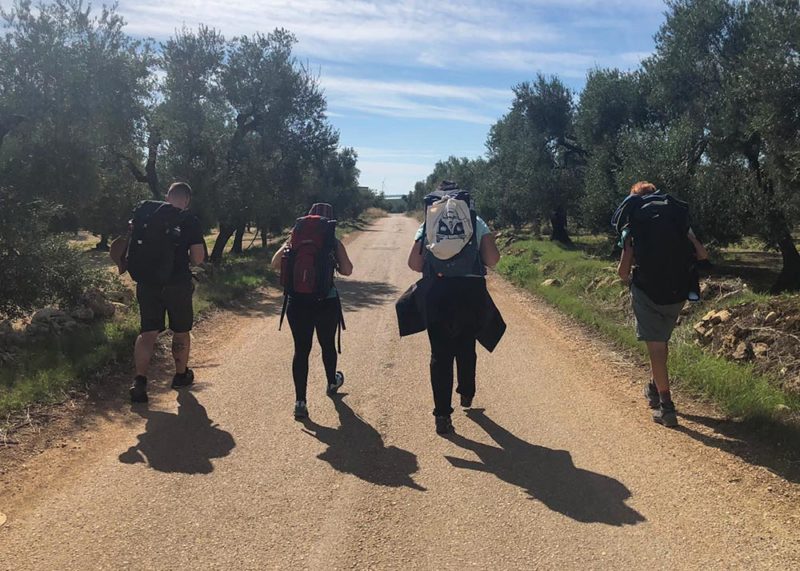
All images © Val Nicastro
I’ve often wondered what’s so special about walking for days in any weather when you can quickly zip from one place to the other by car or public transportation. So I gave it a try.
While there’s no shortage of exciting paths to explore in Italy, I decided to walk the Via Peuceta, a relatively new trail that winds through Apulia and Basilicata.
This 170km route goes from Bari to Matera in seven stages. This isn’t a religious pilgrimage but rather a complete immersion into the rich cultural and historical heritage of this beautiful corner of southern Italy.
I was sold the minute I browsed the dedicated website illustrating the path’s ever-changing scenery.
From olive groves and lush forest to steppe expanses and karst incisions, the landscape along the Via Peuceta is a visual rollercoaster – with the added bonus of extraordinary culinary traditions along the way.
The network of referenti di tappa (the volunteers who take care of the stages of the path) was another reason I chose the Via Peuceta over other trails.
Knowing I could call someone in case of difficulty was a good feeling, since I was already picturing myself lost in the woods hunting for food!
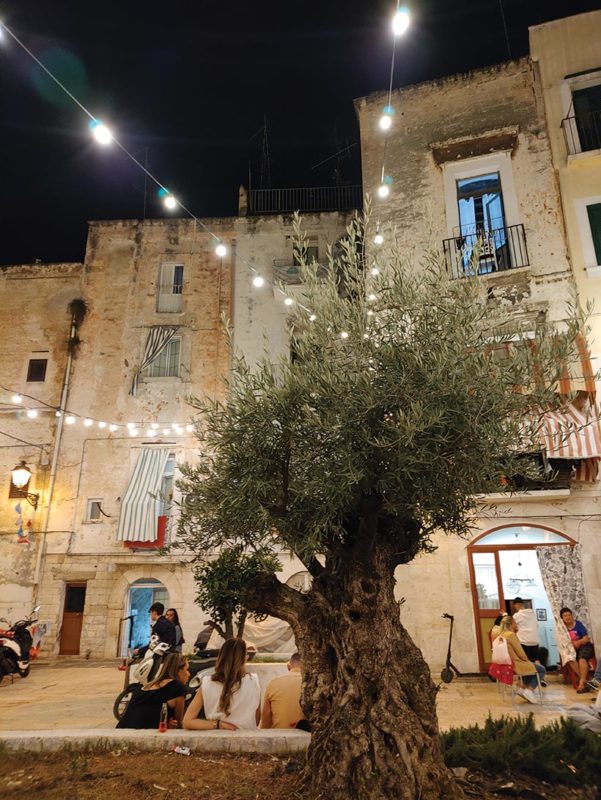
Arriving in Bari
I arrived in Bari on a late September evening and explored it the following day. I highly recommend you do the same because Apulia’s capital is full of charm, especially Bari Vecchia, its old town.
Imagine it as a living exhibit of colourful humanity, with ladies making orecchiette in the street, half-opened windows revealing scenes of domestic life through lace curtains, and the scent of food filling the air.
Plus, there are tons of historical landmarks to discover.
After a full day of sightseeing (which should be counted as an additional stage!), I bade farewell to Bari with an iced Peroni beer and a bag of sgagliozze (slices of fried polenta) along the lungomare.
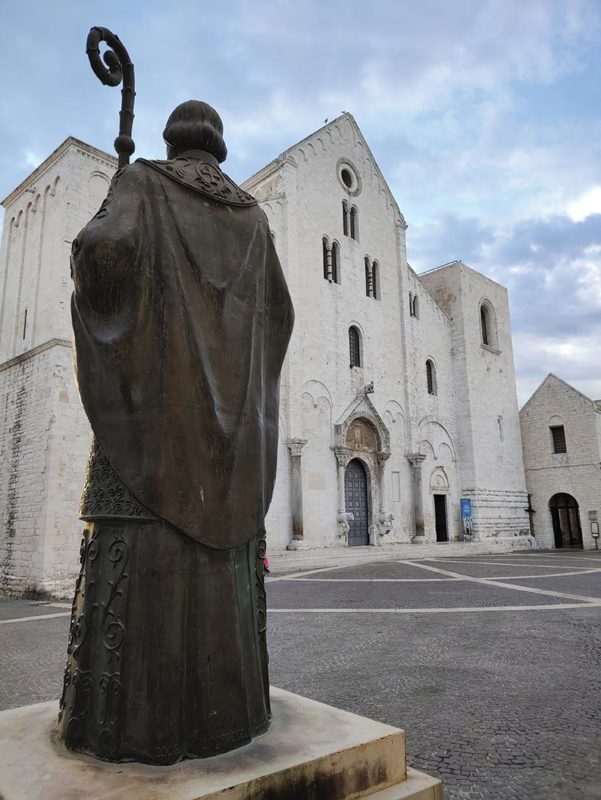
Day 1: From Bari to Bitetto (17km)
At dawn the following day, I reached the Basilica of San Nicola, the official starting point of the Via Peuceta, ready to start hiking with my 30-litre backpack and that mixture of excitement and anxiety that comes with big adventures.
After passing by the grand Norman Swabian Castle, I made my way to the Adriatic Bridge, which leads into Bari’s industrial suburbs.
I won’t lie, this first part of the trail wasn’t great, as I had to walk along busy, dirty roads.
Fortunately, it wasn’t all that long before I entered the countryside, taking the ancient medieval road that once linked Bari to Bitetto.
Along the way, I passed vineyards, olive groves, a curious herd of deer and llamas, and even a stunning fortified estate dating from the 11th century – the Casale di Balsignano – which you can, if you have time to stop, tour on your own or with a guide.
Continuing onward, I eventually arrived at Bitetto, my final destination for the day. Here I stayed at the home of Ester, the local referente di tappa, where I met the four fellow hikers who would become my companions for the rest of the journey.
Ester took us to some places around town, including the laboratory of Mino Marrone, a local artisan who gave us each a bracelet in the colours of the Via Peuceta (green and yellow).
We even saw the festa del paese, with parades, fireworks, and street food. The perfect end to an intense first day on the trail!
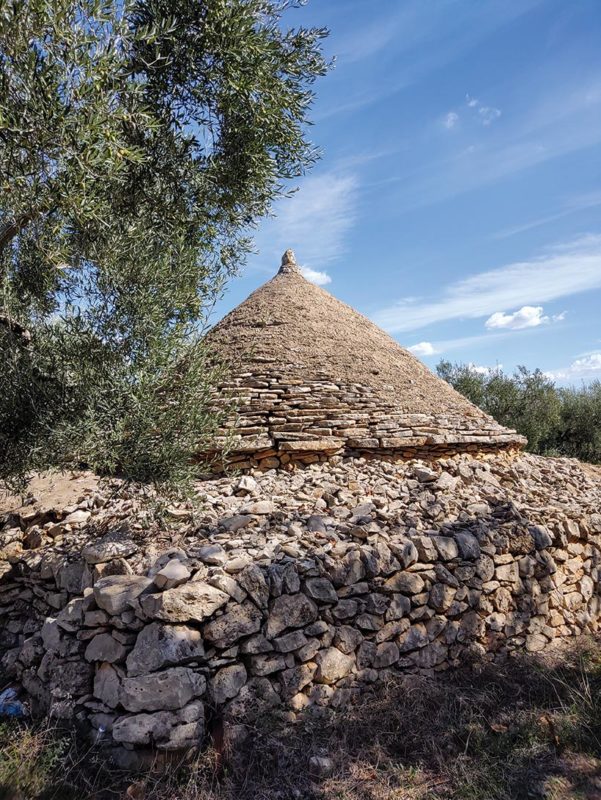
Day 2: From Bitetto to Cassano delle Murge (25km)
After enjoying the bountiful breakfast basket Ester had prepared the night before, I set off with my new travel buddies.
Leaving the town, we entered a lush countryside with postcard-like views of vineyards and olive groves.
It was impossible not to stop for photos with all those dry stone walls, rural construction, and occasional trulli, Apulia’s iconic stone huts with their conical roofs.
The sun was always high and hot, with hardly any shade and no places for refreshments. Thank goodness I did my homework before leaving and had very high sun protection, three litres of water, and energising food.
The last part of this stage had a couple of challenging climbs (at least for me) to reach the Sanctuary of Santa Maria degli Angeli, which sits atop a karst cave where the Virgin Mary is said to have appeared back in the 13th century.
That was our final stop before entering Cassano delle Murge, where we found accommodation at Le Dimore del Garibaldi in the town centre and feasted of traditional dishes.
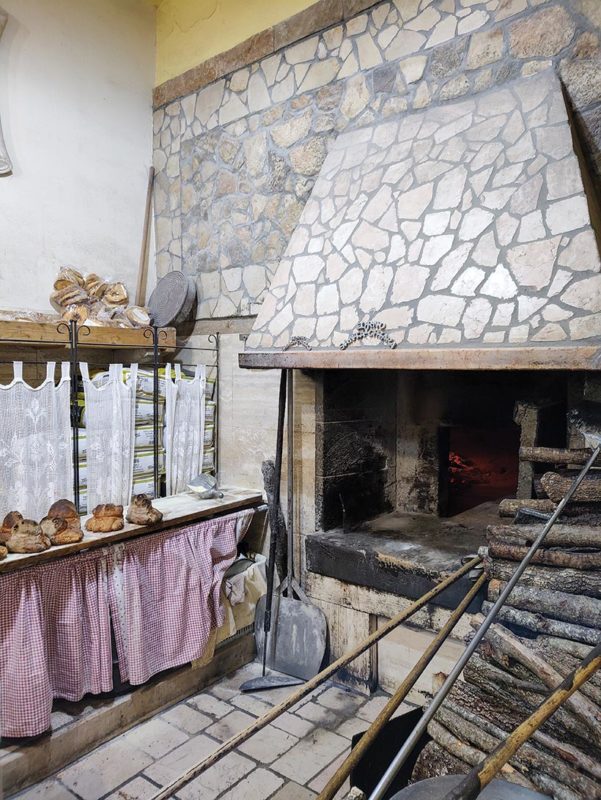
Day 3: From Cassano delle Murge to Santeramo in Colle (22km)
Day Three brought a change in scenery. As the path led away from the olive groves, we encountered the Mesola Wood, whose rich flora makes it a highly valuable green space.
Slowly, the wood thinned out and the landscape changed yet again, with vast wheat fields, barren pasture and a stone path accompanying us to Arome, a B&B and pilgrim rest stop where we sat and chatted with the owner, Giovanni.
From here, it was another hour or so to Santeramo in Colle, passing through the beautiful Galietti pine forest, which was refreshingly shady.
As always, we lingered over chats and local specialities in the evening. And we visited one of the town’s famous fornelli, the butcher’s shops where you can pick your meat and have it grilled right there.
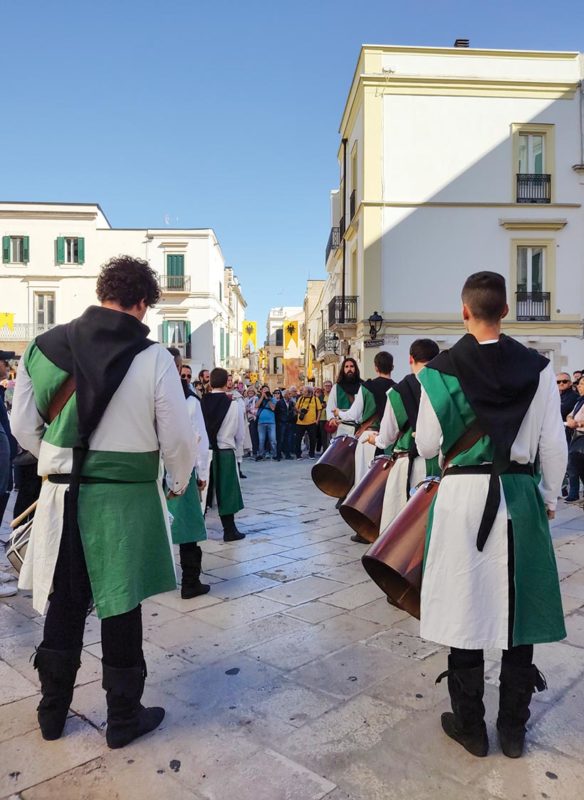
Day 4: From Santeramo in Colle to Altamura (23km)
By day four, my feet had started to feel separated from my body, but, against all odds, I was halfway through and couldn’t be happier.
From the historical centre of Santeramo we proceeded to the heart of Alta Murgia, one of Italy’s largest sub-steppe areas.
Along the way, we stopped at Masseria Scalera, a family-run farmhouse, where we caught the farmer in action as he prepared mozzarella – a real treat!
We then continued walking through fields dotted with little gems like the rupestral settlement of Fornello.
As we arrived in Altamura, the town was in full party mode for Federicus, a major medieval festival honouring its founder, the Swabian Emperor Frederick II.
After visiting the beautiful Cathedral and tasting the famous Altamura bread in the ancient Santa Chiara bakery, we joined locals on the streets of the historical centre, which had been turned into a giant medieval playground.
They certainly know how to throw a party in Altamura!
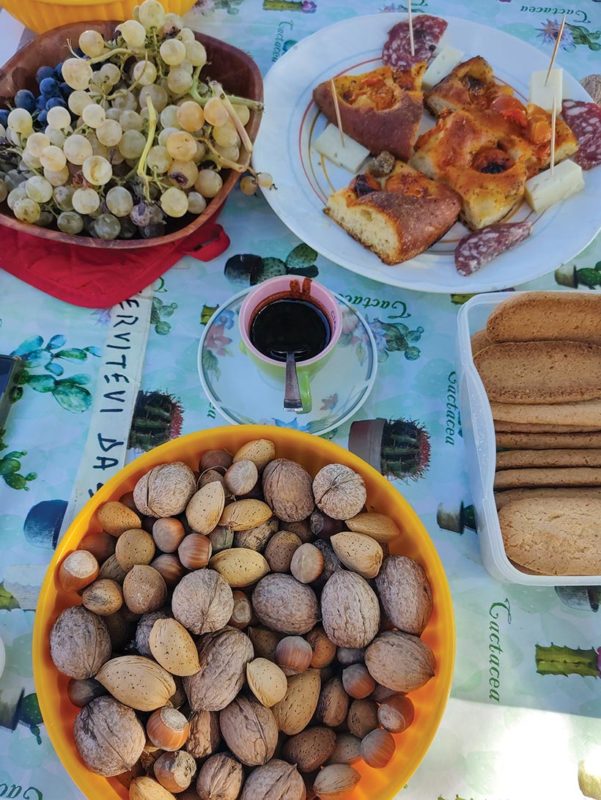
Day 5: From Altamura to Gravina in Puglia (20km)
In preparation for the last two days, which were supposed to be pretty tough, this fifth stage was a bit shorter and easier.
As we hiked through vast expanses of fields, we came upon Masseria Casalia, where Mr. Peppino always has a table set for hikers.
He offered us snacks and a glass of homemade walnut liqueur to fuel up on while listening to tales of his beautiful land.
After leaving a small donation, we continued through vast areas of arable land and wooded spots to Gravina in Puglia, where the view of an ancient Roman aqueduct greeted us.
Leonardo, one of the trail’s coordinators and the owner of the B&B where we stayed, told us all about this little Apulian gem set on the edge of a ravine, with a picturesque historical centre and a fascinating underground world.
Dinner was at Osteria Sant’Agostino, where the pilgrim menu comprised a variety of appetisers and a great dish of homemade pasta, topped off with local red wine.
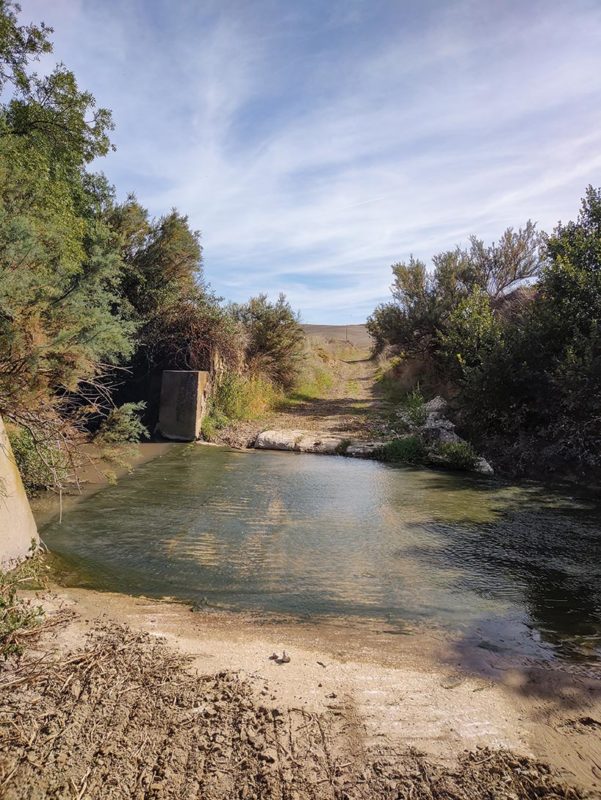
Day 6: From Gravina in Puglia to Picciano (30km)
This was undoubtedly the best but most challenging part of the Via Peuceta.
We woke up at the crack of dawn and crossed the stone bridge, stopping to admire the rocky landscape of Gravina from the other edge of the ravine.
Taking a cobblestone road, we crossed a disused railway track, passed fields with horses grazing freely, and then walked into the Bosco Difesa Grande, one of Apulia’s largest woods.
Parts of it had been heavily damaged by arson, but it was nice to see the vegetation was recovering.
We also found a small box with a “pilgrim diary” where we could record our passage.
After stopping for lunch in the woods, we had a challenging climb up. Eventually, what goes up must come to an end, and we found ourselves in a mesmerising landscape of gentle hills and vast expanses of clayey soil.
This is Fossa Bradanica, right at the border between Apulia and Basilicata. Next, we passed a tiny village oddly called Borgo Picciano B and started the last descent to the Benedictine sanctuary of Picciano, the final destination of this stage.
It was hard, physically and mentally, but you can’t imagine the sense of accomplishment in reaching the top of that hill!
Upon arriving, Maria Laura , the referente di tappa, picked us up and took us to her farmhouse, Masseria La Fiorita, a beautiful working farm where we had a fabulous organic dinner and slept like babies.
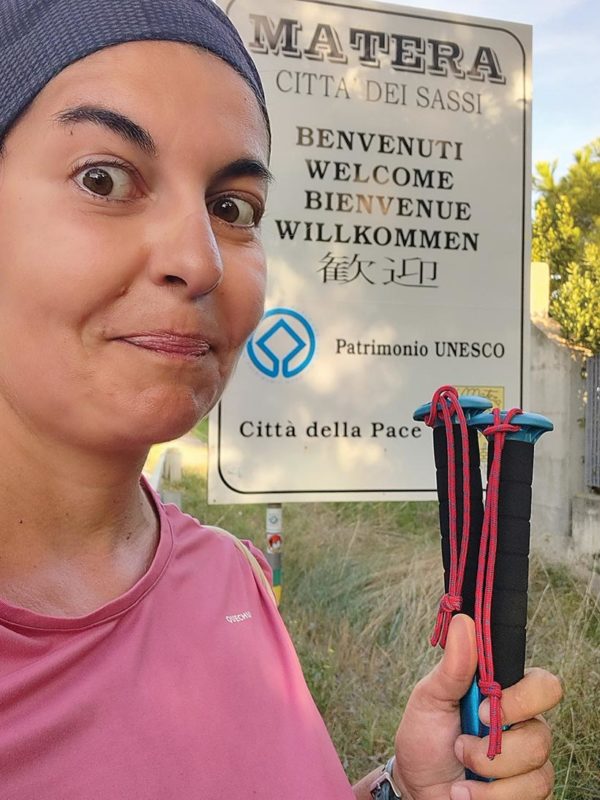
Day 7: From Picciano to Matera (30km)
The next morning we took our time to enjoy Maria Laura’s sumptuous breakfast, which included fresh milk from the farm’s own cows. Her partner, Pasquale, then drove us to the starting point of this last stage, and off we went.
The first part of the walk was flat and easy, running through the fields, with the occasional tractor punctuating the landscape.
We then passed the San Giuliano Nature Reserve, one of the most important wetlands in Basilicata , where we stopped to rest by an artificial lake.
The trail continued on dirt roads lined with prickly pears and olive trees up to a small stream, whose cold water was a real treat for my aching feet. A few more climbs and some hysterical laughing later, the Sassi of Matera were right in front of us!
After receiving the Testimonium that certifies the completion of the Via Peuceta , I celebrated the end of this incredible adventure by foot with one last pilgrim menu, accompanied by precious memories, strangers who had become friends, and one of the best sunsets of my life.
Val’s top tips for walking the Via Peuceta
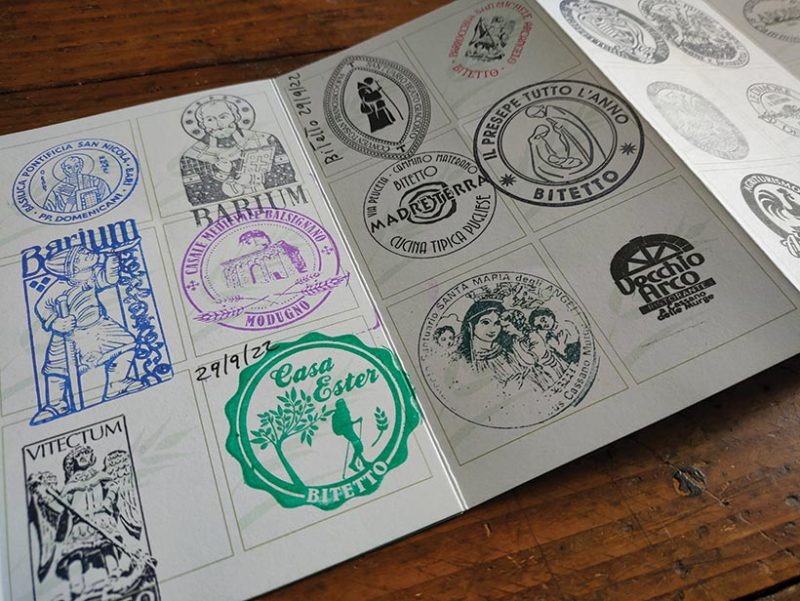
1. The network
The Via Peuceta is part of the Cammino Materano, a network of six paths to discover southern Italy at its most authentic.
2. La Credenziale
Before departing, you should request the credenziale, a sort of hiker’s passport to access the network of accommodation and restaurants and get the Testimonium at the finish.
3. Yellow or green?
The path can be walked in both directions – the yellow arrows on the route point to Matera and the green ones to Bari.
4. Choose your season
You can hike the Via Peuceta all year round, but spring is the best time to see the countryside in full bloom.
5. Pilgrim’s menus
There’s a pilgrim menu available in every location along the path (€15-€20), as well as stamps to collect that prove your passage.
Discover more travel blogs in our archive
